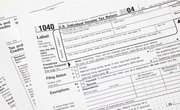
You cannot use a fax number for the IRS to file your tax return. While they sometimes accept faxes for some ongoing tax issues, like audits and problems with returns that are already being processed, they don’t even publish numbers for people to fax tax returns to, generally speaking.
Tips
You cannot fax or email your tax return, but better options are available.
You’ll only be given a fax number by an IRS representative who is specifically requesting information from you or your tax preparer. And their fax numbers change. So if you’ve used an IRS fax number in the past, don’t count on it working the next time.
You Cannot Fax Tax Returns
While you cannot fax your tax return, you can’t email them either. You have two options for filing your tax return: e-file it or mail it. IRS guidelines promote e-filing and for good reason. It’s generally safer, faster and easier than preparing a paper return and mailing it. Additionally, when you e-file and have a refund coming, you can choose the direct deposit option and you’ll get your refund much faster than if you file by mail.
Pick Your e-File Method
The IRS offers four e-filing options for individual taxpayers:
- E-file yourself by using the IRS’s Free File or Fillable Forms. Both are available through their website. You can use Free File if your adjusted gross income is $69,000 or less. Use Fillable Forms if you adjusted gross income is over $69,000.
- E-file by using one of the IRS’s volunteer-staffed services. The Volunteer Income Tax Assistance program will help you prepare your return and e-file it for you if you make $56,000 or less, have a disability or have limited English speaking skills.
- E-file through an authorized e-file provider. Authorized e-file providers can be individuals or firms. Businesses that specialize in tax preparation, like H&R Block, are authorized e-filers. All of their tax return preparers are covered under the firm’s Electronic Filing Identification Number. Individual IRS-authorized tax providers have to follow IRS guidelines and go through an approval process that includes a background check. The background check may include looking at their credit report, finding out if they have a criminal history, and checking to see if they've been filing and paying their own taxes. The IRS has an online database where you can search for authorized IRS e-file providers in your area. You just need to enter your ZIP code or select your state.
- Commercial software is another way to prepare and e-file your tax return. TurboTax, H&R Block and Tax Act have all been approved to transmit tax returns to the IRS electronically. While you can’t e-file directly from QuickBooks, they do offer a self-employed tax bundle that allows you to export data directly to TurboTax. One caveat: the export can only be done one time. If you notice you’ve made an error or the export fails, you’re back to entering everything into TurboTax manually.
Read More: The Federal Gift Tax and Holiday Giving
Fix Mistakes with Form 1040x
As part of the e-filing process, the IRS’s computers automatically check your return for errors. If they find a minor error, like a mathematical mistake, they'll fix it themselves or bounce the return back to you so you can fix it and resubmit. However, if you discover a mistake, you should wait until your original return is processed and you’ve received your refund, if a refund is due. Then file a Form 1040X, an amended return. Amended returns cannot be e-filed. You have to mail them.
Mailing Your Return
You can still mail your tax return but it will take longer to process and longer to receive a refund than if you e-file. A typical paper Form 1040 can take the IRS six to eight weeks to process.
If you’re going to mail a paper return, you need the right address to send it to. Where you send your return or amended return depends on the state you live in, what form your filing and whether or not you’re enclosing a payment with the return. You can find the right address on the IRS’s website titled Where to File Paper Tax Returns With or Without a Payment. Find your state on the list and click on it. A new page opens that has a list of addresses for your state and they’re sorted according to whether or not you’re enclosing a payment.
It might be worth it to spend an extra few bucks and use certified mail. With certified mail you can get a receipt with the date and time on it that proves you mailed your return. After it’s been delivered, you’ll receive written proof of that, too. The peace of mind is well worth it.
Know the Due Dates
Regardless of how you file your return, you must file it by April 15. If April 15 happens to fall on a Saturday, Sunday or legal holiday, you have until midnight the next business day following April 15 to file. If you’re requesting an extension, you have to file Form 4868 by April 15. This will give you until Oct. 15 to file your return either by mail or e-filing
If you’re filing late or filing an amended return, you must do so by mail. None of the e-filing options work for late or amended returns. Your return is late if you’re filing after April 15 without having requested an extension. If you requested an extension, you can still e-file through Oct. 15.
Paying Taxes and Getting Refunds
Whether you e-file or mail your return, you can pay your tax bill online by authorizing an electronic withdrawal from your checking account through the IRS’s Direct Pay service. You can also still mail a check or money order. If you mail your payment, you should enclose Form 1040-V. It's a very short form that just requires your name, address, Social Security number and the amount you’re paying.
Read More: When Can You Get That Tax Refund?
References
- GovTrack.us: H.R. 5444: Taxpayer First Act
- GovTrack.us: H.R. 5445: 21st Century IRS Act
- IRS.gov: How to File
- IRS.gov: e-File Options for Individuals
- IRS.gov: Where to File Paper Tax Returns With or Without a Payment
- IRS: Become an Authorized e-File Provider
- IRS: Free Tax Return Preparation for Qualifying Taxpayers
- IRS.gov. "Electronic Filing Options for Individuals." Accessed March 19, 2020.
- Benefits.gov. "Free File." Accessed March 19, 2020.
- IRS.gov. "Understanding Tax Return Preparer Credentials and Qualifications." Accessed March 19, 2020.
- IRS.gov. "Get Your Refund Faster: Tell IRS to Direct Deposit your Refund to One, Two, or Three Accounts." Accessed March 19, 2020.
- IRS.gov. "Free File: Do Your Federal Taxes for Free." Accessed March 19, 2020.
- IRS.gov. "Apply Online for a Payment Plan." Accessed March 19, 2020.
- TaxAct. "Check E-File Taxes Status." Accessed March 19, 2020.
- H&R Block. "Accuracy/Calculation Guarantee." Accessed March 19, 2020.
- IRS.gov. "Frequently Asked Questions to Help Taxpayers Obtain IRS Tax Products." Accessed March 19, 2020.
Writer Bio
LeDona Withaar has over 20 years’ experience as a securities industry professional and finance manager. She was an auditor for the National Association of Securities Dealers, a compliance manager for UNX, Inc. and a securities compliance specialist at Capital Group. She has an MBA from Simmons College in Boston, Massachusetts and a BA from Mills College in Oakland, California. She has done volunteer work in corporate development for nonprofit organizations such as the Boston Symphony Orchestra. She currently owns and operates her own small business in addition to writing for business and financial publications such as Budgeting the Nest, Zacks and PocketSense.

